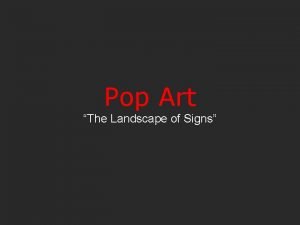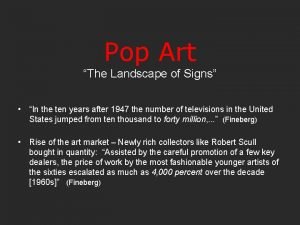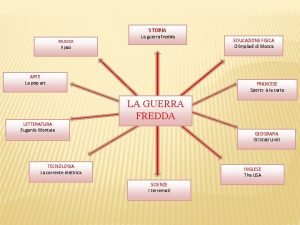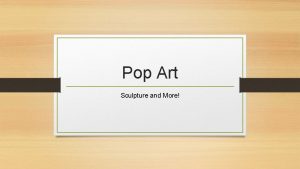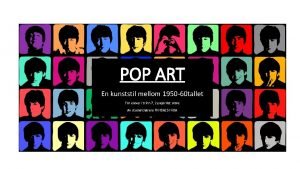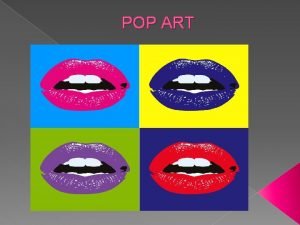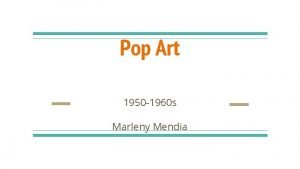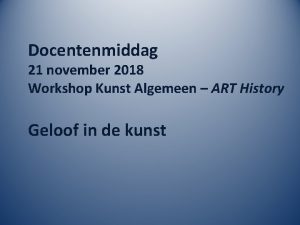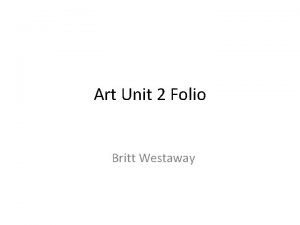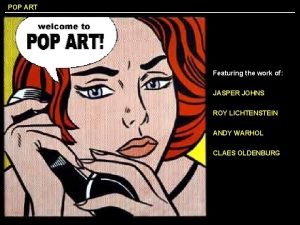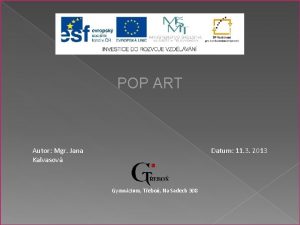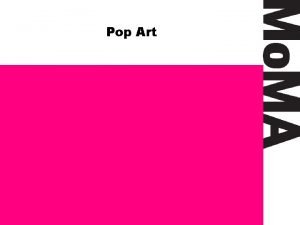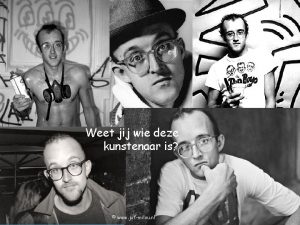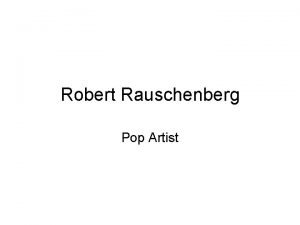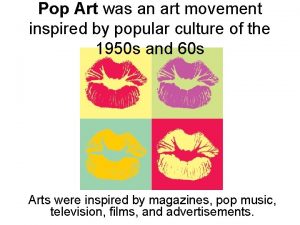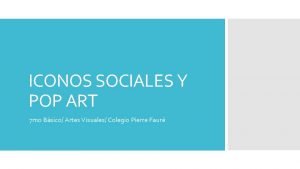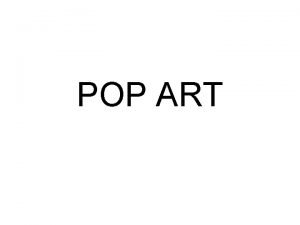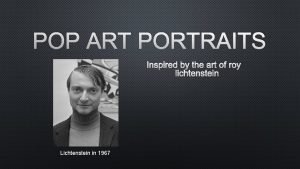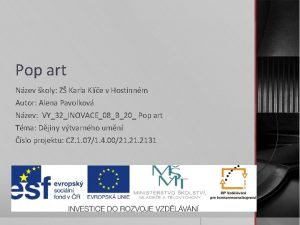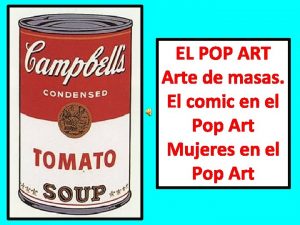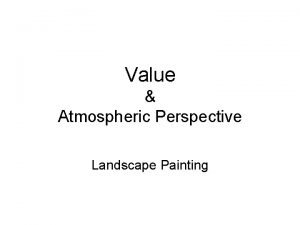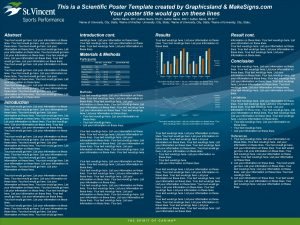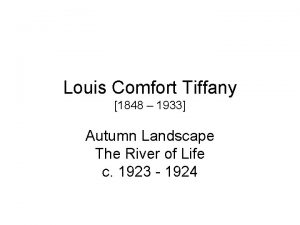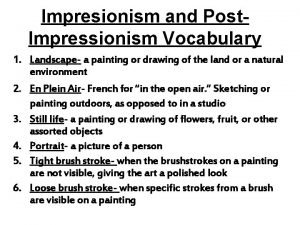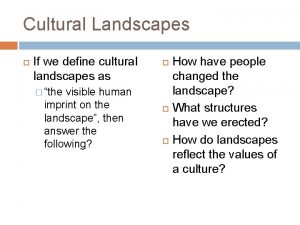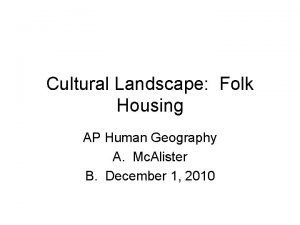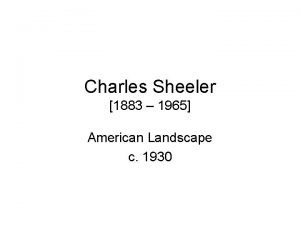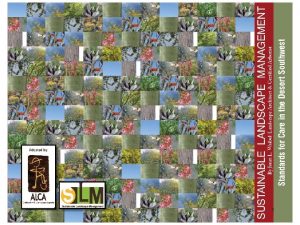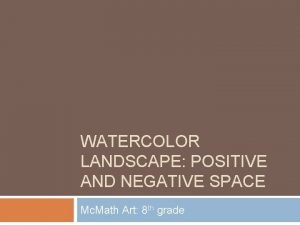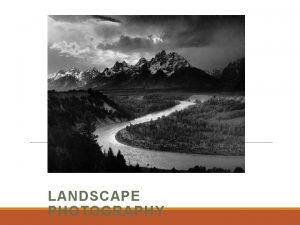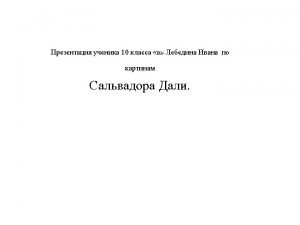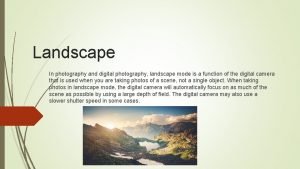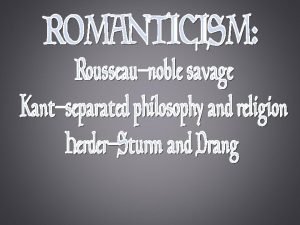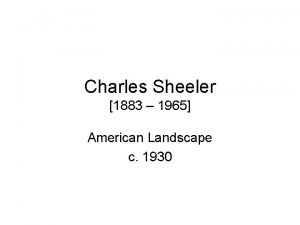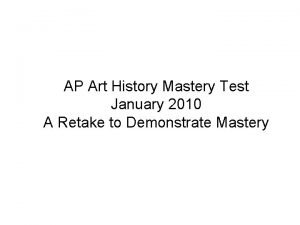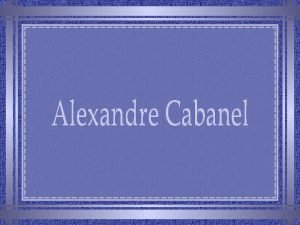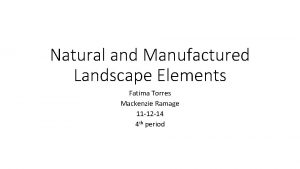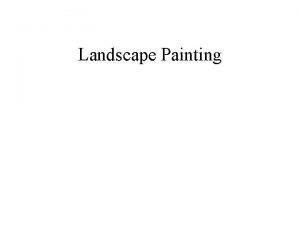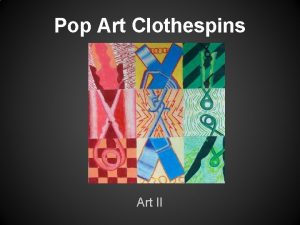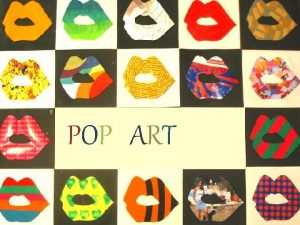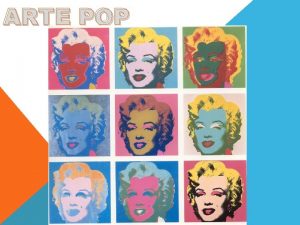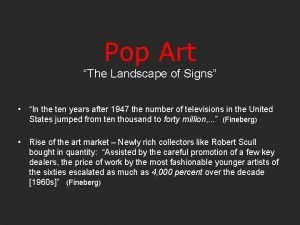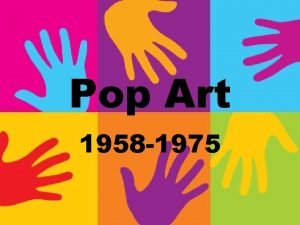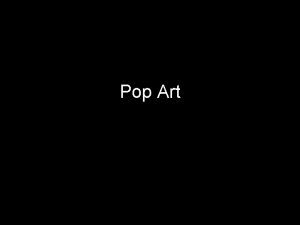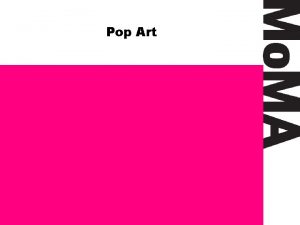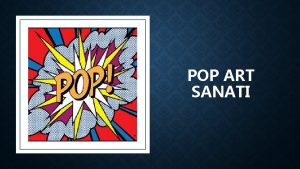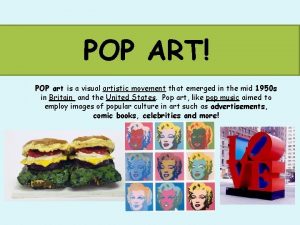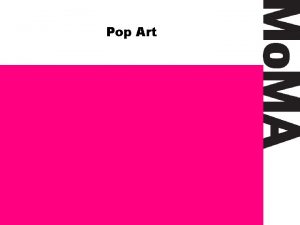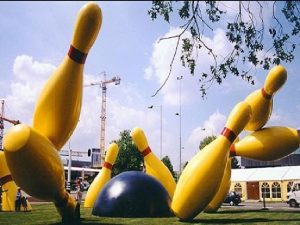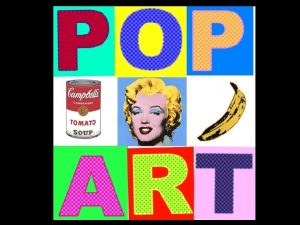Pop Art The Landscape of Signs In the






































































![Gerhard Richter (b. Dresden, 1932), [Nazi officer] Uncle Rudi, 1965, oil on canvas (right) Gerhard Richter (b. Dresden, 1932), [Nazi officer] Uncle Rudi, 1965, oil on canvas (right)](https://slidetodoc.com/presentation_image_h2/a538d97bf9df4b42820cbdb9f58a15f1/image-71.jpg)





























- Slides: 100

Pop Art “The Landscape of Signs” • “In the ten years after 1947 the number of televisions in the United States jumped from ten thousand to forty million, . . . ” (Fineberg) • Rise of the art market – Newly rich collectors like Robert Scull bought in quantity: “Assisted by the careful promotion of a few key dealers, the price of work by the most fashionable younger artists of the sixties escalated as much as 4, 000 percent over the decade [1960 s]” (Fineberg)

POP ART BEGAN IN LONDON (left) Francis Bacon (British, 1909 -1992), Head Surrounded by Sides of Beef, 1954, British Existential Figuration; (right) Eduardo Paolozzi (British, 19242005), Real Gold, collage, 14 x 19 in. , 1950, British Pop

The Blitz: From September 7 1940 through May 1941, the German Luftwaffe bombed British cities, especially London, almost nightly. Here London fire fighters extinguish flames following an air raid. More than 43, 000 deaths and 1, 400, 000 people were made homeless, 4 million homes destroyed or badly damaged.

(left) Eduardo Paolozzi Its a Psychological Fact That Pleasure Helps Your Disposition, 1948, collage. Affirmative or adversarial (avant-garde) posture? Shown in his influential 1952 “Bunk” slide lecture that marks the beginning of British Pop. “Bunk” is from Henry Ford: “history is more or less bunk…. we want to live in the present. ” (right) Hannah Höch, The Beautiful Girl, collage (photomontage), 1919, Berlin Dada / Adversarial posture toward commercial culture – what was Paolozzi’s attitude towards it?

Eduardo Paolozzi, (right) I was a Rich Man's Plaything 1947; (left) Meet the People, 1948, from Ten Collages from 1952 BUNK lecture, collage mounted on card support, 14 x 9. 5 in. “The iconography of a new world. ”

Richard Hamilton (British, b. 1922) Just What is it That Makes Today's Homes So Different, So Appealing? Collage (photomontage), 10 x 9”, 1956, Kunsthalle. Tübingen, Tubingen, Germany. British Pop Hamilton defined Pop Art in a letter dated January 16, 1957: "Pop Art is: popular, transient, expendable, low-cost, massproduced, young, witty, sexy, gimmicky, glamorous, and Big Business. " 1964

The Independent Group’s “This is Tomorrow” exhibition, 3 installation views, 1956, Whitechapel Gallery (Institute of Contemporary Art) London

Richard Hamilton, (left) Towards a Definitive Statement on the Coming Trends in Men's Wear and Accessories (a) Together Let Us Explore the Stars 1962; (right) $he, 1958 -61, both oil & collage on canvas, British Pop

(left) Richard Hamilton, The Large Glass or The Bride Stripped Bare by her Bachelors, Even, 1963, an exact copy and homage to (right) Marcel Duchamp, The Large Glass or The Bride Stripped Bare by her Bachelors, Even 1915 -23; (center) Photo of Duchamp by Hamilton, c. 1968

Hans Namuth, photograph marking the 25 th Anniversary of Leo Castelli Gallery, 1982. Standing left – right: Ellsworth Kelly, Dan Flavin, Joseph Kosuth, Richard Serra, Lawrence Weiner, Nassos Daphnis, Jasper Johns, Claes Oldenberg, Salvatore Scarpitta, Richard Artschwager, Mia Westerlund Roosen, Cletus Johnson, and Keith Sonnier Seated left – right: Andy Warhol, Robert Rauschenberg, Leo Castelli, Ed Ruscha, James Rosenquist, and Robert Barry In the late fifties and Sixties, “There were two Camps, mine and Clement Greenberg’s. “ Leo Castelli

Andy Warhol (American, 1928 -1987), Bonwit Teller window decor, NY, April 1961; (left) Dick Tracy, 1960, casein and crayon, 48” high; A Boy for Meg, 1962 oil on canvas, 72” high

Andy Warhol, 32 Campbell’s Soup Cans, 1962, acrylic on canvas, screened with hand painted details, 20 x 16 in. ea (lower right) Ferus Gallery installation, Los Angeles, 1962. Warhol’s first gallery show. Five canvases sold for $100 each, but Irving Blum, co-owner of Ferus, bought them back to keep the set intact and later partly gifted them to Mo. MA NYC http: //www. moma. org/audio_file/1110/OE_24 _Campbell. Soup. Cans_edit. mp 3

Jasper Johns (American, b. 1930), Painted Bronze, hand painted cast bronze, 1960, Proto-Pop (Neo-Dada) (right) Warhol, Campbell Soup Can, 1968, screened acrylic on canvas, Pop Art

Andy Warhol and Gerard Malanga (1967) silk-screening in the Factory, located on the fifth floor at 231 East 47 th Street in Midtown Manhattan. The Factory moved to 33 Union Square West in 1967. Warhol used silkscreen from 1962 on.

(right) Warholstars group portrait by Gerard Malanga, 1968(? ); (left) film still and poster for Warhol's film Exploding Plastic Inevitable, 1966, with the Velvet Underground. The Andy Warhol Museum owns 273 Warhol films and almost 4, 000 videotapes. “If you want to know all about Andy Warhol, just look at the surface of my paintings and films and me, and there I am… There’s nothing behind it. ” - Andy Warhol

Warhol, (left) Gold Marilyn Monroe, 1962, acrylic, silkscreen and oil on canvas; (right) Marilyn, 1962. Series followed Monroe’s (probable) suicide in August 1962.

Andy Warhol, Marilyn Diptych, 1962, acrylic silkscreen on canvas

Andy Warhol, 210 Coca-Cola bottles, 1962, Silkscreen, ink & synthetic polymer paint on canvas, 6’ 10” x 8’ 9”

Warhol, (left) Jackie, The Week That Was, 1963 (right) Suicide 1963, Acrylic and silkscreen, 6’ H

Warhol, Five Deaths Eleven Times in Orange, synthetic polymer paint, silk-screened on canvas, 1963

Warhol, (left) Lavender Disaster, 1971; (right top and below) Electric Chair, 1971, screenprints. “Everything I do is connected with death. ” (Warhol, 1978)

Andy Warhol, Brillo Box, 1964, acrylic and silkscreen on plywood, 17 x 15 in At the Tate Modern: the conundrum “Greenberg’s narrative … comes to an end with Pop … It came to an end when art came to an end, when art, as it were, recognized there was no special way a work of art had to be. ” - Arthur Danto (1964) After the End of Art, 1997 “Is an endless playing with the definition of art all that art now has to offer? ” - Charles Harrison “Conceptual Art” (Themes)

Roy Lichtenstein (American, 1923 -1997), cover of Newsweek, 1966, New York Pop Art

Roy Lichtenstein’s educational background: (left) Reginald Marsh (Lichtenstein’s teacher at the Art Students’ League, NYC), Why Not Take the “L”? , oil on canvas, 1930 (right) Flash Lab, Ohio State, where Lichtenstein studied 1942 -44

Roy Lichtenstein, Girl With a Ball, 1960 compare with Andy Warhol, Dick Tracy, 1960, New York Pop Art. When Warhol saw Lichtenstein’s cartoon paintings in 1960 he stopped making them.

Roy Lichtenstein screened and handpainted ben day dots, a method of mechanical color printing, evident below in detail from a 1964 painting http: //www. lensculture. com/lambrecht. h tml? this. Pic=2 See slide show of Roy Lichtenstein studio / process

Roy Lichtenstein, WAAM! 1963, Magna on canvas, 2 panels; 68 x 166 inches overall; source: a 1962 issue of DC Comics' All-American Men of War “Lichtenstein was not painting things but signs of things. ” Fineberg



James Rosenquist, President Elect, oil on masonite, 12 feet wide, 1960 -1 (New York Pop Art); (right) mockup for painting and (below) artist in studio “I’m interested in contemporary fission – the flick of chrome, reflections, rapid associations, quick flashes of light. Big-bang! Bing-bang! I don’t do anecdotes; I accumulate experiences. ”

Rosenquist, (left) right & left halves of F-111, installation, oil on canvas and aluminum, 23 sections, 10 x 86 feet, 1964 -5, The Museum of Modern Art, NY


http: //vodpod. com/watch/4830179 -theartview-power-up-female-pop-art-at-kuntsthalle Marisol, Baby Boy, 1963 Marisol, The Family, 1963

Claes Oldenburg, Snapshots from the City, performance with first wife, Pat Muschinski, at Judson Gallery, Judson Memorial Church, New York. February 29, March 1 -2, 1960. Performance / Happening at Oldenburg’s “Ray Gun Theater” (right) The Street installation 1960

Claes Oldenburg, The Store, Dec. 1, 1961 - Jan. 31, 1962, Ray Gun Mfg. Co. , 107 East Second Street, New York. Roast Beef, 1961, inside studio/store (with artist), view looking out, poster, Green Gallery sponsor. “I am for an art that is political-erotic-mystical, that does something other than sit on its ass in a museum. ”

Claes Oldenburg (American, born Sweden, 1929). Pastry Case, I. 1961 -62. Painted plaster sculptures on ceramic plates, metal platter and cups in glass-and-metal case, 21 x 30 x 15, " New York Pop Art "I make my work out of my everyday experiences, which I find as perplexing and extraordinary as can be. “ Oldenburg, 1960

Claes Oldenburg. (American, born Sweden, 1929). Green Gallery Installation (2 views), 1962; Floor Cake (right) 1962. Synthetic polymer paint and latex on canvas filled with foam rubber and cardboard boxes, 58 3/8" x 9' 6 1/4" x 58 3/8“. Pop Art

Claes Oldenburg, Bedroom Ensemble, life size, wood, vinyl, metal, artificial fur, cloth, paper, 1963, National Gallery of Canada, Ottowa. Oldenburg took a perspective drawing of a set of bedroom furniture from a newspaper advertisement, built his furniture in 3 -D, giving them the forms they had in 2 -D. “This is the kind of reality that if you intrude it vanishes. ” Oldenburg http: //cybermuse. gallery. ca/cybermuse/search/artist_e. jsp? iartistid=4095

Oldenburg, Soft Toilet, 1966; Dormeyer Mixer, 1965

Oldenburg, Giant Lipstick, erect (left) and limp (center), Yale University, 1969. Anti-Vietnam war

Claes Oldenburg, Clothespin, 1976, Cor-Ten and stainless steels, 45 ft. x 12 ft. 3 in. x 4 ft. 6 in. , Centre Square Plaza, Philadelphia. Scale. Carnivalesque humor in public art, as well as inside art world joke in allusion to Brancusi’s 1909 Kiss (above).

Wayne Thiebaud (US, b. 1920), Five Hot Dogs, 1961, o/c, 18 x 24 in, Whitney MAA Thiebaud earned a BA degree from Sacramento State College in 1941 an M. A. degree in 1952. Thiebaud’s “Pop” work was in The New Realist show at Sidney Janis (1962 NYC) with other major figures associated with Pop, New Realism, and Gutai

Wayne Thiebaud, Cakes, 1963

Edward Kienholz (US, 1927 -1994), Back Seat Dodge ’ 38 (two views), 1964, tableau with truncated Dodge and mixed materials (plaster casts, beer bottles, chicken wire, artificial grass, etc. ) Los Angeles Funk

Edward Kienholz, The Wait, 1964– 65. Tableau: wood, fabric, polyester resin, flock, metal, bones, glass, paper, leather, varnish, black-and-white photographs, taxidermed cat, live parakeet, wicker, and plastic, 80 × 160 × 84 in. (life size) overall. Whitney Museum of American Art, New York

Kienholz, Ed, The State Hospital (INTERIOR), 1966, Tableau: plaster casts, fiberglass, hospital beds, bedpan, hospital table, goldfish bowls, live black fish, lighted neon tubing, steel hardware, wood, paint 96 x 144 x 120 in. Moderna Museet, Stockholm

Kienholz, Ed, The State Hospital (EXTERIOR), 1966, Tableau: plaster casts, fiberglass, hospital beds, bedpan, hospital table, goldfish bowls, live black fish, lighted neon tubing, steel hardware, wood, paint 96 x 144 x 120 in. Moderna Museet, Stockholm

http: //www. youtube. com/watch? v=Mv. Jvy. FBcv. D 4 Joseph Cornell, Medici Boy, 1942 -52 Betye Saar (Los Angeles, b. 1930, mixed heritage African, Native American, Irish and Creole). The Liberation of Aunt Jemima, mixed-media assemblage, 1972, BAMFA. Saar began making assemblages after seeing a 1968 exhibition works by Joseph Cornell (1903 -1972).

Robert Arneson (Benicia, CA 1930 -1992)

Robert Arneson, John with Art, 1964, glazed ceramic with polychrome epoxy, life size, Seattle Art Museum, gift of Manuel Neri

Robert Arneson, Typewriter, 1966, glazed ceramic, around 6 x 11 x 12 in. UC Berkeley Art Museum

1966 -76

Robert Arneson, ceramic sculpture California Artist, 1982, on display in front of his studies for the sculpture, Museum of Modern Art, San Francisco

Richard Shaw (US based in Fairfax, CA, b. 1941) Sac State Festival of the Arts 2011 speaker (left) Seated Figure with Landscape, ceramic, 13 x 14 x 32", 2005 (right) Seated Figure with Gray Head, 1985, porcelain with glazed transfers, 33 x 23 x 10 in. http: //www. richardshawart. com/sparkedmovie. html

New Realism (Nouveau Réalisme) International, Paris-centered movement named after the eponymous exhibition at Sidney Janis Gallery in New York in 1962 AKA the “Slice of Cake School” (Time magazine)

Yves Klein (Nouveau Réalist, French, 1928 -1962) (left) Monochrome Blue 3 (IKB [International Klein Blue], 1960, pigment & resin on canvas on wood, c. 6’ H; Compare (right) Kasimir Malevich, Black Suprematist Square, 1914 -15, and (below) compare exhibitions: 1960 Klein and (right) 1915 Malevich (Russian Suprematism) Klein produced 194 monochromes between 1955 -1961

Yves Klein, Anthropométrie performances, Paris, 1960 Anthropométrie de l’époch bleue (Anthropometry of the Blue Epoch), pure pigment in resin on paper mounted on canvas, 1960, Nouveau Réalisme

Yves Klein, (left) Le Vide (The Void), Iris Clert Galérie, Paris 1958, gallery installation; (right) Leap into the Void, March 9, 1960, New Realism, altered photograph

Daniel Spoerri (Swiss, born Romania, 1922), Hungarian Meal, Trap Picture, 1963, assemblage: metal, glass, porcelain, fabric on painted chipboard In the gallery, which was converted into a restaurant, dishes prepared by Spoerri - who was a great cook - were served by famous critics. After the mean, the guests constructed their own Trap-Pictures by gluing down what was on their tables as is. Called “Eat Art” by Spoerri who later founded the Eat Gallery in Dusseldorf

Christo Javacheff (Bulgarian-American, 1935 - ) Nouveau Réalisme (New Realism), Wall of Barrels, Iron Curtain, 1961 -2, 240 oil barrels, 168” high; (right) Wrapped Wheelbarrow, 1963 (Christo met Jean-Claude, his lifetime partner, in Paris in 1958)

Niki de Saint-Phalle, (New Realist, French-American, 1930 -2002), Crucifixion, 1963, Fabric pasted over an armature of wire mesh and various affixed objects, 100” high; (right) Jean Dubuffet (Postwar Existentialism, French 1901 -1985) A Tree of Fluids, 1950

“In 1961 I shot at: Daddy, all the men, small men, tall men, important men, fat men, my brother, society, church, school, my family, my mother, all the men, Daddy, myself, men again. ” Niki de Saint-Phalle “Shoot” paintings

Niki de Saint-Phalle, Hon ("She" in Swedish), 1966. 6 ton colossus (82'/20'/30'). With Jean Tinguely and Per Olaf Ultvedt as a temporary installation at the Moderne Museet, Stockholm. One of a series of “Nana” sculptures The Carnivalesque

Niki de Saint Phalle and Jean Tinguely, Pompidou Center kinetic Stravinsky fountain from the top floor of the Beaubourg art museum & cultural center. (far left) View of Stravinsky fountain at pavement level

Jean Tinguely (Nouveau Réalist, Swiss 1925 -91), Homage to New York, Kinetic eventsculpture that self-destroyed in the garden of the Museum of Modern Art. New York, March 17, 1960

Tinguely’s Nouveau Réalisme Sources: Dada: Marcel Duchamp, (left) Bicycle Wheel (readymade), 1913; (right) Duchamp, Rotorelief, rotative plaques, glass, metal, motor, 1920, kinetic art; (below left ) Francis Picabia (French, 1879 -1953), Amorous Parade, 1919 Tinguely’s Homage to New York 1960

The Way Things Go (German: Der Lauf der Dinge) is a 1987 kinetic art video by the Swiss artists Peter Fischli and David Weiss. The 30 -minute film is a classic of contemporary art: absurdist, dadaist for sure, fascinating. See The Way Things Go after class this. Thursday for extra credit. “It is 6 September 1985. In exactly 134 days the space shuttle will explode shortly after take-off, inscribing an eerily beautiful plume of white vapour in the sky. Another 88 days later, again due to a chain of human errors and structural faults, Chernobyl's block four reactor will go into meltdown. ” (Patrick Frey – see Tate website http: //www. tate. org. uk/tateetc/issue 8/fischliweiss_waythingswent. htm)

Above: Survival Research Labs robot Click link for part of a 2006 performance in San Jose: http: //www. youtube. com/watch? v=L 5 Jh. QCJBYd. Q

Gerhard Richter and Konrad Lueg, Living With Pop, 1963: a performance of “Capitalist Realism. ” The Düsseldorf artist group (Richter, Lueg, and Sigmar Polke) mounted an installation of objects in a local furniture store, installing themselves with the commodities for sale (“living sculptures”) as a demonstration of "Capitalist Realism. " To what earlier, state-supported realisms was "Capitalist Realism" responding? Richard Hamilton, 1956

(left) Richter and Sigmar Polke, 1965, from Richter/Polke exhibition catalogue (right) Richter, 1998, from Gerhard Richter: 40 Years of Painting exhibition cat.
![Gerhard Richter b Dresden 1932 Nazi officer Uncle Rudi 1965 oil on canvas right Gerhard Richter (b. Dresden, 1932), [Nazi officer] Uncle Rudi, 1965, oil on canvas (right)](https://slidetodoc.com/presentation_image_h2/a538d97bf9df4b42820cbdb9f58a15f1/image-71.jpg)
Gerhard Richter (b. Dresden, 1932), [Nazi officer] Uncle Rudi, 1965, oil on canvas (right) Administrative Building, 1964, Oil on canvas, 38 1/4 x 59 “ photo sources – family snapshot and encyclopedia “I believe in nothing” [Richter] “…photography. . . had no style, no composition, no judgment. It freed me from personal experience. That’s why I wanted to have it – not to use it as a means to painting but to use painting as a means to photography. - Richter

Gerhard Richter, Aunt Marianne, oil on canvas, 1965, 47 x 51 in from a photograph of Richter as a baby with Aunt Marianne “Whenever I behaved badly I was told you will become like crazy Marianne. ”

Gerhard Richter, Phantom Interceptors, 1964, oil on canvas, 55" x 6' 3“ (right) Alpha Romeo (With Text), 1965, oil on canvas, 60” x 59” What is grisaille?

Richter, Eight Student Nurses, 1966, oil on canvas, 8 individual paintings, each c. 36 x 27 in

Compare Gerhard Richter’s Eight Student Nurses, 1966 with Andy Warhol’s Jackie: The Week That Was, 1963

(left) Gerhard Richter, Abstract Painting, 1976, oil on canvas, 26 x 23 in. “After the gray paintings, after the dogma of ‘fundamental painting’ whose purist and moralizing aspects fascinated me to a degree bordering on self-denial, all I could do was start all over again. This was the beginning of the first color sketches. ” Compare concept of Rauschenberg’s Factum I & II, 1957

Gerhard Richter, October 18, 1977: Baader-Meinhof series, Confrontation 1 and 2, 1988, oil on canvas, all 45” H. The subject is Ulrike Meinhof, the Baader-Meinhof group or gang – part of the Red Army Faction, was the first of the Marxist terror groups that killed bankers, politicians and bystanders across 70 s Europe.

October, 1977, news photo of protesters in Stuttgart at funeral of Andreas Baader


Final paintings in Gerhard Richter’s October 18, 1977 Baader-Meinhof series titled Tote 1, 2, and 3

(left) Gerhard Richter, Betty (Richter’s daughter), 1988, oil on canvas, 40 x 23“ (right) Richter, October 18, 1977 [Ulrike Meinhof] : Baader-Meinhof series, Confrontation 1, 1988. Both oil paintings were made in 1988.

(left) Gerhard Richter, Iceberg in Fog, 1982, oil on canvas, 27 x 39 in compare (left) Caspar David Friedrich (German Romantic Painter, 1774 -1840) (top) Monk by the Sea (1809) and (bottom) Polar Sea (1823)

Gerhard Richter, Untitled, 1987, oil on canvas, 118” square

Richter, Betty, 1988, oil on canvas, 40 x 23“ compare (right) Untitled, oil, 1987, 118” “Painting is the form of the picture, you might say. The picture is the depiction, and painting is the technique for shattering it. ”

Lichtenstein, cover Of Newsweek, 1966 Sigmar Polke, Bunnies, 1966, acrylic on linen, 58 x 39” A “raster” painting (commercial printing process showing “benday” dots) Warhol, "Marilyn, " 1964

Sigmar Polke (German, 1941 -1910), (left) Modern Art, 1968 (right) Polke, Lovers II, 1965, oil and enamel on canvas, 6 ft 3 in x 55 in

Ralph Goings, 2011 exhibition poster, Airstream, 1970, oil on canvas, 60 x 85 in. MUMOK, Museum Moderner Kunst Stiftung Ludwig Vienna

Richard Estes (born Kewanee, Illinois, 1932) Telephone Booths, 1968, acrylic on masonite, 48 x 69 in. , Museo Thyssen-Bornemisza, Madrid. Signature subjects are urban street life – mostly New York City – of the late ‘sixties and ‘seventies.

Duane Hanson (US, 1925– 1996), Woman with Dog, 1977, cast polyvinyl polychromed in synthetic polymer, with cloth and hair, 46 × 48 × 51 in. overall. Whitney Museum of American Art, New York

Chuck Close (US, 1940) Self-Portrait, 1967 -8, acrylic on canvas, c. 9 x 6 ft. , Walker Art Center, Minneapolis.

Vija Celmins (US based in LA, b. Latvia 1939), Pan, oil on canvas 24 x 35 in. , 1964

Vija Celmins, Suspended Plane, 1966, oil on canvas, 24 x 35 x 2 ½ in. , SFMOMA [Celmins on painting process: http: //www. sfmoma. org/multimedia/videos/99 ]

Ed Ruscha (US, based in Los Angeles, b. 1937), Standard Station, Amarillo, Texas, 1963, oil on canvas, 5 ft 5 in x 10 ft/ Pop and Minimalism/ CA car culture In 1962 Ruscha was included, along with Lichtenstein, Warhol, Thiebaud, et al, in the groundbreaking "New Painting of Common Objects, " curated by Walter Hopps at the Pasadena Art Museum. Ruscha’s first solo exhibition was in 1963 at the Ferus Gallery in LA.

Ed Ruscha, Large Trademark with Eight Spotlights, 1962, oil on canvas, 5 ft 6 in X 11 ft 1 in, Whitney Museum of American Art, New York. Hollywood culture

Ed Ruscha, Flying A, Kingman, Arizona, from Twentysix Gasoline Stations, 1963, photographic book, sold for $3. 50 Minimalist and California Pop (anti)aesthetic: serial repetition and deadpan view of contemporary reality Book cover http: //www. sfmoma. org/multimedia/videos/202 Ruscha on his art (1 minute)

Through his deliberate lack of style, Ruscha draws attention “to the estranged relationship of people to their rural environment, but without staging or dramatizing the estrangement. ” Compare Ruscha’s (1963) vision of the American West (above) with Ansel Adams’ interpretation based on 19 th century Romantic landscape aesthetics (right) Moonrise over Hernandez, N. M. October 31, 1941. Adams made “Art” and did not work in other media: skill-based vs. Ruscha’s concept-based photography

Ansel Adams, Grand Tetons and the Snake River, 1942 The artist’s road trip, California ><Oklahoma Albert Bierstadt, The Rocky Mountains, 1863

Ed Ruscha took the photographs of Sunset Strip with a motorized Nikon camera mounted to the back of a pick-up truck. This allowed him to photograph every building while driving – first down one side of the street and then the other. The pictures were then pasted in order they were shot, and the individual buildings were labeled with their respective address numbers. Conceptual and Minimal.


Ed Ruscha, The Old Trade School Building, 2005, synthetic polymer on canvas 54 x 120 in. , from The Course of Empire Series, US Pavilion, Venice Biennale, 2005 (bottom) Blue Collar Trade School, 1992, Synthetic polymer on canvas, 54 x 120 in.
 Pop art signs
Pop art signs Pop art signs
Pop art signs Signs signs everywhere signs meaning
Signs signs everywhere signs meaning What does pop in pop art stand for
What does pop in pop art stand for Landscape art definition
Landscape art definition Op art landscape
Op art landscape Conventional language
Conventional language The color of a recreation area sign is ______________.
The color of a recreation area sign is ______________. The diamond shape is used exclusively for _____ signs.
The diamond shape is used exclusively for _____ signs. Workshop pop art
Workshop pop art Montale guerra fredda
Montale guerra fredda Lichtenstein portraits
Lichtenstein portraits Pop art sculpture
Pop art sculpture Movement art
Movement art Pop art 1950
Pop art 1950 Expresionismo abstracto caracteristicas
Expresionismo abstracto caracteristicas Pop art 1960
Pop art 1960 Pop art 1950-1960
Pop art 1950-1960 Kari
Kari Kunst
Kunst Pop art reino unido
Pop art reino unido Pop art mind map
Pop art mind map Andy warhol pop art
Andy warhol pop art Pop art autor
Pop art autor Pop art theme
Pop art theme Elimi beş yerinden dağladı sözleri
Elimi beş yerinden dağladı sözleri Xxx pop art
Xxx pop art Juf milou kunst
Juf milou kunst Brainpop independent and dependent variables
Brainpop independent and dependent variables Rauschenberg
Rauschenberg Contemporary pop music
Contemporary pop music Pop art benday dots
Pop art benday dots Project pop art
Project pop art Iconos sociales pop art
Iconos sociales pop art Seeds quiz
Seeds quiz Definisi pop art
Definisi pop art 50 pop art
50 pop art What was pop art rebelling against
What was pop art rebelling against Pop art title
Pop art title Pop art self portrait
Pop art self portrait Pop art prezentace
Pop art prezentace Tecnicas del pop art
Tecnicas del pop art Definisi pop art
Definisi pop art Vendor landscape meaning
Vendor landscape meaning Atmospheric perspective landscape
Atmospheric perspective landscape Topic xiv
Topic xiv Scientific poster template
Scientific poster template Semiotic landscape examples
Semiotic landscape examples Landscaping goals and objectives
Landscaping goals and objectives What is mobility panorama and explain its types
What is mobility panorama and explain its types Societal marketing concept
Societal marketing concept Louis comfort tiffany autumn landscape
Louis comfort tiffany autumn landscape Cultural landscape convergence
Cultural landscape convergence No bird soars too high essay
No bird soars too high essay Landscape section of a health policy analysis
Landscape section of a health policy analysis Post impressionism landscape
Post impressionism landscape Depositional landscapes
Depositional landscapes What is the meaning of cultural landscape
What is the meaning of cultural landscape New england folk housing
New england folk housing Classic landscape charles sheeler
Classic landscape charles sheeler Nomadic warrior theory
Nomadic warrior theory Distance decay ap human geography
Distance decay ap human geography Landscape with two poplars
Landscape with two poplars Karst landscape examples
Karst landscape examples Forrester cmp
Forrester cmp Arizona landscape contractors association
Arizona landscape contractors association Winter landscape with a bird trap
Winter landscape with a bird trap West 8 architecture
West 8 architecture Positive and negative space landscape
Positive and negative space landscape Space analysis template
Space analysis template Uniform landscape definition
Uniform landscape definition Viasr
Viasr Digital twin landscape
Digital twin landscape Pharma 101
Pharma 101 Navigating the digital landscape
Navigating the digital landscape Ore mines in india
Ore mines in india Landscape with the fall of icarus summary
Landscape with the fall of icarus summary 11 surefire landscape photography tips
11 surefire landscape photography tips Landscape of figueres
Landscape of figueres Landscape mode photography
Landscape mode photography Landscape hotels world congress
Landscape hotels world congress Rainier landscape design
Rainier landscape design Hanging valley glacier
Hanging valley glacier Charles sheeler, classic landscape, 1931.
Charles sheeler, classic landscape, 1931. Winter landscape with church friedrich
Winter landscape with church friedrich Charles sheeler american landscape
Charles sheeler american landscape History of art mastery test
History of art mastery test Carracci flight into egypt
Carracci flight into egypt Alexandre cabanel biography
Alexandre cabanel biography What makes a landscape distinctive
What makes a landscape distinctive Bear creek landscape
Bear creek landscape Map
Map Machine learning landscape
Machine learning landscape Site inventory architecture
Site inventory architecture Account for the present religious landscape in australia
Account for the present religious landscape in australia What is narrative stylistics
What is narrative stylistics Romantic era landscape painting
Romantic era landscape painting 3e secret de fatima
3e secret de fatima Devegetation and defacing of landscape
Devegetation and defacing of landscape 6-1 a changing landscape
6-1 a changing landscape Helen frankenthaler mountains and sea
Helen frankenthaler mountains and sea
